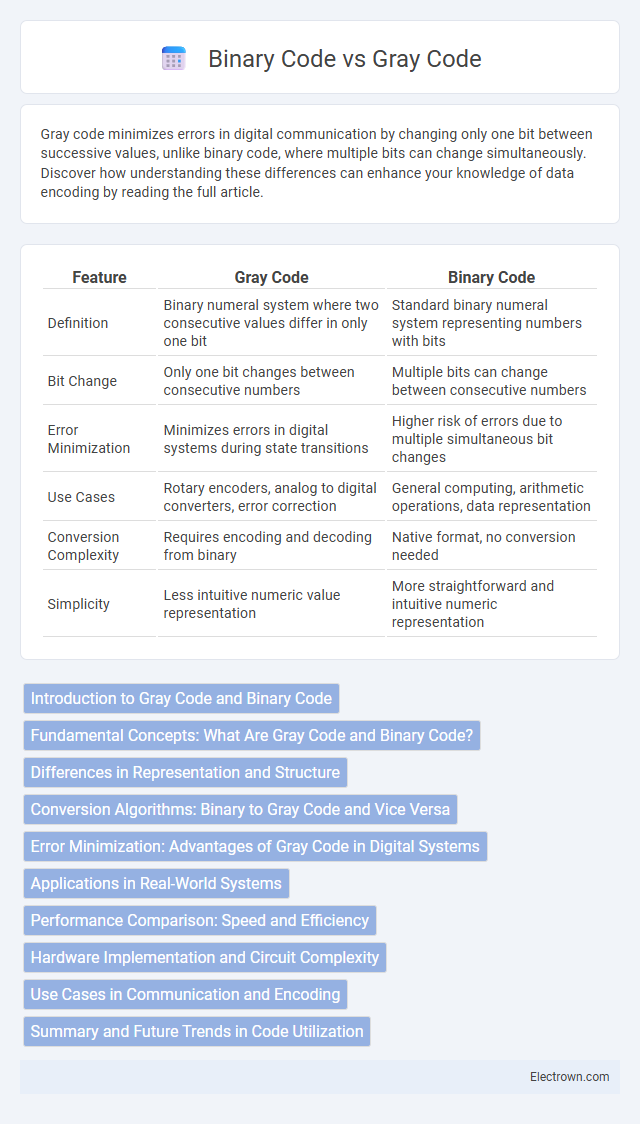Gray code minimizes errors in digital communication by changing only one bit between successive values, unlike binary code, where multiple bits can change simultaneously. Discover how understanding these differences can enhance your knowledge of data encoding by reading the full article.
Table of Comparison
| Feature | Gray Code | Binary Code |
|---|---|---|
| Definition | Binary numeral system where two consecutive values differ in only one bit | Standard binary numeral system representing numbers with bits |
| Bit Change | Only one bit changes between consecutive numbers | Multiple bits can change between consecutive numbers |
| Error Minimization | Minimizes errors in digital systems during state transitions | Higher risk of errors due to multiple simultaneous bit changes |
| Use Cases | Rotary encoders, analog to digital converters, error correction | General computing, arithmetic operations, data representation |
| Conversion Complexity | Requires encoding and decoding from binary | Native format, no conversion needed |
| Simplicity | Less intuitive numeric value representation | More straightforward and intuitive numeric representation |
Introduction to Gray Code and Binary Code
Gray Code is a binary numeral system where two successive values differ in only one bit, minimizing errors in digital communications and mechanical encoders. Binary Code, the standard method for representing numbers in computing, uses bit patterns where multiple bits may change between successive values, increasing the risk of errors during transitions. Understanding the differences between Gray Code and Binary Code helps you choose the right system for error-sensitive applications or traditional digital processing.
Fundamental Concepts: What Are Gray Code and Binary Code?
Gray Code and Binary Code are both binary numeral systems used to represent data, but they differ fundamentally in error minimization and bit transitions. Binary Code represents values in a straightforward binary sequence, with bits changing according to standard positional values, while Gray Code ensures only one bit changes between successive values to reduce errors in digital communication and mechanical encoders. Understanding these concepts helps optimize your digital systems for accurate data transmission and signal processing.
Differences in Representation and Structure
Gray code differs from binary code in that each successive value changes by only one bit, minimizing errors in digital communication and mechanical encoders. Binary code represents numbers using a straightforward positional system where each bit represents a power of two, allowing for direct arithmetic operations. Gray code's structure reduces the possibility of glitches during transitions, whereas binary code is preferred for computation due to its simplicity and ease of conversion.
Conversion Algorithms: Binary to Gray Code and Vice Versa
Conversion between binary code and Gray code involves specific algorithms that ensure accurate encoding and decoding. To convert binary to Gray code, the most significant bit (MSB) remains the same, and each subsequent Gray bit is obtained by XOR-ing the current binary bit with the previous binary bit. Converting Gray code back to binary requires iteratively XOR-ing the Gray bits, where each binary bit is derived by XOR-ing the previous binary bit with the current Gray bit, preserving error minimization in digital communication systems.
Error Minimization: Advantages of Gray Code in Digital Systems
Gray Code significantly reduces errors in digital systems by ensuring that only one bit changes between successive values, minimizing the chance of misinterpretation during transitions. This single-bit change property helps prevent glitches and transient errors commonly found in binary code, where multiple bits can flip simultaneously. Your digital circuits and communication systems benefit from enhanced reliability and accuracy by implementing Gray Code for error-sensitive applications.
Applications in Real-World Systems
Gray Code is extensively used in rotary encoders and position sensors due to its property of changing only one bit between successive values, which minimizes errors during transitions. Binary Code finds broad applications in digital computing systems, memory addressing, and arithmetic operations where straightforward binary representation and manipulation are essential. Gray Code is also favored in communication systems and error correction algorithms to reduce the chance of misinterpretation during signal changes.
Performance Comparison: Speed and Efficiency
Gray Code reduces errors in digital systems by changing only one bit between successive values, enhancing speed in error-prone environments like rotary encoders. Binary Code offers straightforward arithmetic operations, making it efficient for general computation but more vulnerable to transitional errors during value changes. Your choice depends on prioritizing error minimization with Gray Code or computational simplicity with Binary Code for optimal performance.
Hardware Implementation and Circuit Complexity
Gray Code reduces hardware implementation complexity by minimizing bit changes between consecutive values, leading to fewer switching errors in digital circuits such as encoders and error correction systems. Binary Code, while simpler to generate using standard binary counters, often requires more complex circuitry to handle synchronization and error detection due to multiple bit changes per transition. Gray Code's hardware advantage lies in lower circuit complexity for applications requiring precise state detection, whereas Binary Code prioritizes straightforward arithmetic operations with slightly higher risk of transient errors.
Use Cases in Communication and Encoding
Gray Code minimizes errors in digital communication by changing only one bit between consecutive values, making it ideal for rotary encoders and analog-to-digital converters where signal integrity is critical. Binary Code is widely used in computing and data storage due to its straightforward binary arithmetic and compatibility with digital circuits. Gray Code enhances error correction and reduces noise in systems like position sensors and communication protocols, while Binary Code remains dominant for general-purpose encoding and processing tasks.
Summary and Future Trends in Code Utilization
Gray Code minimizes errors by ensuring only one bit changes between successive values, making it ideal for error-sensitive applications like rotary encoders and digital communication. Binary Code remains dominant in general computing due to its straightforward arithmetic and compatibility with standard processors. Your choice between these codes will increasingly depend on emerging technologies such as quantum computing and fault-tolerant systems, where hybrid or adaptive coding schemes may become essential.
Gray Code vs Binary Code Infographic

 electrown.com
electrown.com